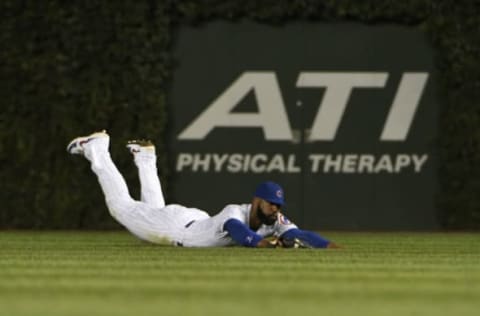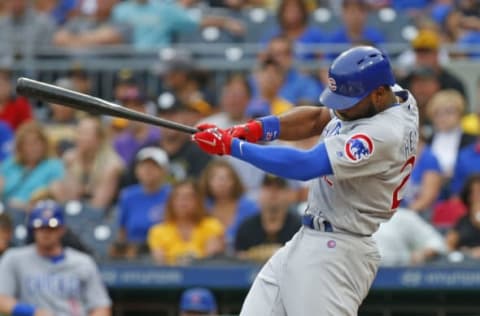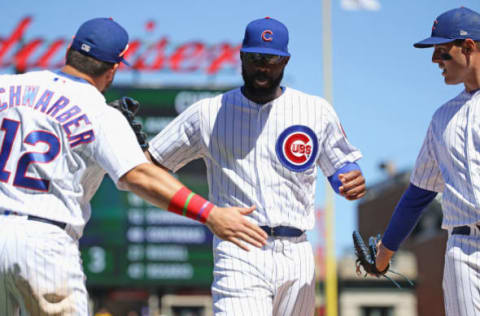Chicago Cubs: Jason Heyward remains a key to this team’s future


Much of this offseason’s headlines will center around Bryce Harper. Regardless of whether or not the Chicago Cubs land him, Jason Heyward will be a huge piece.
With the Boston Red Sox up two games to none in the Fall Classic, a great many fans are already turning their attention to the upcoming offseason. With a free agent class loaded with franchise-altering talent, the Chicago Cubs and the other 29 teams are all licking their chops.
And who could blame them? This year’s free agent class includes Bryce Harper, Manny Machado and, potentially, Los Angeles Dodgers left-hander Clayton Kershaw, who has an opt-out in his deal with L.A.
We know the Cubs, for their part, won’t stand pat. The days of talking about guys’ potential like some kind of half-baked pipe dream are over. Evaluations will be made based on performance, not promise. And that change in mindset could drastically alter what this roster looks like in 2019.
One guy you can pretty much guarantee takes the field on Opening Day 2019? Outfielder Jason Heyward, who is heading into year four of his eight-year, $184 million deal. You can forget about him exercising his opt-out clause in his deal. It’s not going to happen.
Knowing that, let’s look at what Heyward brings to Chicago moving forward.

Chicago Cubs: Strides made with the stick
When the Cubs signed Heyward to that eight-year deal, he was coming off a strong showing with the rival St. Louis Cardinals. He batted .293/.359/.439, hitting a career-high 33 doubles in 154 games.
More from Cubbies Crib
- Cubs starting pitching has been thriving on the North Side
- Make no mistake: the Cubs are very much about power hitters
- Cubs are giving pitcher Javier Assad a deserved shot
- Cubs: It’s time to start thinking about potential September call-ups
- Cubs: P.J. Higgins deserves to be in the lineup on a daily basis
During Chicago’s 2016 World Series championship run, Heyward brought a lot to the table – with his glove, that is. His was dismal offensively, with his OPS dropping from .797 to .631 year over year. He rolled over balls on a daily basis and was about the furthest thing from an offensive threat.
But, most people quickly forgave the poor first impression, due to his locker room speech during the Game 7 rain delay. He rallied the troops and helped erase a 108-year title drought. That counts for something.
In 2017, Heyward appeared in just 126 games, and took steps in the right direction. He raised his average back up to .259 en route to a 2.3 WAR campaign. Again, that’s trending up, but remains a far cry from his 6.5 WAR showing with St. Louis in 2015.
Heading into 2018, we were told Heyward had, once again, adjusted his swing and was expecting better results. So what did we see at the dish from the 29-year-old outfielder?

Chicago Cubs: A tumultuous showing in 2018
After going 3-for-10 in the first series of the year in Miami, Heyward cooled off in a big way, hitting .239 in the month of April. But in both May and June, he heated up as temperatures rose in Chicago, giving cause for real optimism.
The main issue, if you’d like to find one, from those two months? He lacked any real power. He hit just two long-balls and slugged below .400 in all but one full month. June stood out as his best single month. He put up an .874 OPS, hit three home runs and slugged .510 – by far the best mark he’s put up recently.
With the glove, he did what he always does. Heyward is undoubtedly one of the best right fielders in all of Major League Baseball. He reads balls well off the bat, has one of the better arms in the league and his reputation clearly precedes him on a daily basis.
Because of injury, Heyward made just 33 plate appearances and he his just .242. He was a non-factor in the Wild Card game, going hitless in three at-bats. So what can/should we expect heading into 2019?

Chicago Cubs: A position change coming for Heyward?
Since joining the Chicago Cubs, Jason Heyward has almost exclusively played right field – and with good reason. He’s an five-time Gold Glove winner at that position, so it makes little sense to move him elsewhere.
But he did see 25 games in center this year (as opposed to 118 in right). It’s worth nothing there is some overlap in those figures, meaning he played both center and right field on a semi-regular basis.
His fielding percentage and range factor were lower in center field than in his natural position. But that’s not to say he was below-average in any regard. But if the Cubs go after Bryce Harper this offseason (and manage to land him), we’re going to see Heyward in center field in 2019.
The most interesting aspect of all this? The sheer amount of payroll tied up in these two guys. Heyward will earn, on average, $21 million annually through 2023. And, according to Bruce Levine of 670 AM The Score, Harper is seeking a big-time payday.
His camp reportedly has a ‘starting point’ of 10 years and $350 million. Now it’s important to note. This isn’t what it will take to get a deal done. This is where discussions will start. If the Cubs signed Harper for, let’s say 12 years and $420 million for a $35 million AAV, that means they’re tying up north of $50 million annually in two outfielders.
With Harper, that makes sense. It’s a tremendous amount of money, sure. But you can justify the financials given what he does on the field, even in down years. But swallowing the next five years of Heyward’s deal grows increasingly difficult when you put them side-by-side.
It’s hard to break down what Jason Heyward will mean to the Cubs moving forward until we see what Theo Epstein does this winter. But this much is sure. They need him to keep making strides at the dish for him to earn his $21 million a year over the next half-decade.
Next. ICYMI: With Bryant extension report, timing is key. dark
If he doesn’t, and the Cubs sign Harper, you’re going to see fans turn on Heyward – regardless of what he’s done in the past or the steps he’s taken to adjust at the plate.